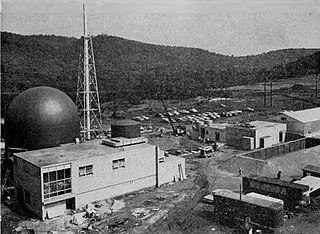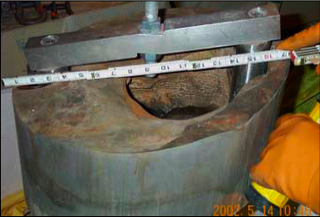
The Three Mile Island accident was a partial nuclear meltdown of the Unit 2 reactor (TMI-2) of the Three Mile Island Nuclear Generating Station. It happened on the Susquehanna River in Londonderry Township, near Harrisburg, Pennsylvania. The reactor accident began at 4:00 a.m. on March 28, 1979, and released radioactive gases and radioactive iodine into the environment. It is the worst accident in U.S. commercial nuclear power plant history. On the seven-point logarithmic International Nuclear Event Scale, the TMI-2 reactor accident is rated Level 5, an "Accident with Wider Consequences".

A nuclear meltdown is a severe nuclear reactor accident that results in core damage from overheating. The term nuclear meltdown is not officially defined by the International Atomic Energy Agency or by the United States Nuclear Regulatory Commission. It has been defined to mean the accidental melting of the core of a nuclear reactor, however, and is in common usage a reference to the core's either complete or partial collapse.

The United States Nuclear Regulatory Commission (NRC) is an independent agency of the United States government tasked with protecting public health and safety related to nuclear energy. Established by the Energy Reorganization Act of 1974, the NRC began operations on January 19, 1975, as one of two successor agencies to the United States Atomic Energy Commission. Its functions include overseeing reactor safety and security, administering reactor licensing and renewal, licensing and oversight for fuel cycle facilities, licensing radioactive materials, radionuclide safety, and managing the storage, security, recycling, and disposal of spent fuel.

Vermont Yankee was an electricity generating nuclear power plant, located in the town of Vernon, Vermont, in the northeastern United States. It generated 620 megawatts (MWe) of electricity at full power. The plant was a boiling water reactor (BWR), designed by General Electric. It operated from 1972 until December 29, 2014, when its owner Entergy shut down the plant. In 2008, the plant provided 71.8% of all electricity generated within Vermont, amounting to 35% of Vermont's electricity consumption. The plant is on the Connecticut River, upstream of the Vernon, Vermont Hydroelectric Dam and used the reservoir pool for its cooling water.

The Limerick Generating Station is a nuclear power plant in Pennsylvania located next to the Schuylkill River in Limerick Township, Montgomery County, northwest of Philadelphia. The facility has two General Electric boiling water reactor (BWR) units, cooled by natural draft cooling towers. According to its owner, Constellation Energy, the two units are capable of producing 2,317 megawatts of power, which combined would provide electricity to around 2 million households. Constellation owns and operates this facility following their separation from Exelon Corporation in 2022. With the exception of refueling outages, Limerick Generating Station continuously operates at 100% power. The plant is connected to the grid, and transmits power, via multiple 500kv transmission lines.

Davis–Besse Nuclear Power Station is an 894 megawatt (MW) nuclear power plant, located northeast of Oak Harbor, Ohio in Ottawa County, Ohio. It has a single pressurized water reactor. Davis–Besse is operated by Vistra Corporation.
Passive nuclear safety is a design approach for safety features, implemented in a nuclear reactor, that does not require any active intervention on the part of the operator or electrical/electronic feedback in order to bring the reactor to a safe shutdown state, in the event of a particular type of emergency. Such design features tend to rely on the engineering of components such that their predicted behaviour would slow down, rather than accelerate the deterioration of the reactor state; they typically take advantage of natural forces or phenomena such as gravity, buoyancy, pressure differences, conduction or natural heat convection to accomplish safety functions without requiring an active power source. Many older common reactor designs use passive safety systems to a limited extent, rather, relying on active safety systems such as diesel-powered motors. Some newer reactor designs feature more passive systems; the motivation being that they are highly reliable and reduce the cost associated with the installation and maintenance of systems that would otherwise require multiple trains of equipment and redundant safety class power supplies in order to achieve the same level of reliability. However, weak driving forces that power many passive safety features can pose significant challenges to effectiveness of a passive system, particularly in the short term following an accident.

The Chernobyl Nuclear Power Plant (ChNPP) is a nuclear power plant undergoing decommissioning. ChNPP is located near the abandoned city of Pripyat in northern Ukraine, 16.5 kilometers (10 mi) northwest of the city of Chernobyl, 16 kilometers (10 mi) from the Belarus–Ukraine border, and about 100 kilometers (62 mi) north of Kyiv. The plant was cooled by an engineered pond, fed by the Pripyat River about 5 kilometers (3 mi) northwest from its juncture with the Dnieper River.

The Browns Ferry Nuclear Power Plant is located on the Tennessee River near Decatur and Athens, Alabama, on the north side of Wheeler Lake. The site has three General Electric boiling water reactor (BWR) nuclear generating units and is owned entirely by the Tennessee Valley Authority (TVA). With a generating capacity of nearly 3.8 gigawatts, it is the third most powerful nuclear power plant in the United States, behind the Palo Verde Nuclear Power Plant in Arizona and the Vogtle Nuclear Power Plant in Georgia, and the most powerful generating station operated by TVA.

The San Onofre Nuclear Generating Station (SONGS) is a permanently closed nuclear power plant located south of San Clemente, California, on the Pacific coast, in Nuclear Regulatory Commission Region IV. The plant was shut down in 2013 after defects were found in replacement steam generators; it is currently in the process of being decommissioned. The 2.2 GW of electricity supply lost when the plant shut down was replaced with 1.8 GW from new natural-gas-fired power plants and 250 MW from energy-storage projects.

The North Anna Nuclear Generating Station is a nuclear power plant on a 1,075-acre (435 ha) site in Louisa County, Virginia, in the Mid-Atlantic United States. The site is operated by Dominion Generation company and is jointly owned by the Dominion Virginia Power corporation (88.4%) and by the Old Dominion Electric Cooperative (11.6%).

Surry Power Station is a nuclear power plant located in Surry County in southeastern Virginia, in the South Atlantic United States. The power station lies on an 840-acre (340 ha) site adjacent to the James River across from Jamestown, slightly upriver from Smithfield and Newport News. Surry is operated by Dominion Generation and owned by Dominion Resources, Inc.

The Fort Calhoun Nuclear Generating Station is a shut-down nuclear power plant located on 660 acres (2.7 km2) between Fort Calhoun, and Blair, Nebraska adjacent to the Missouri River between mile markers 645.6 and 646.0. The utility has an easement for another 580 acres (2.3 km2) which is maintained in a natural state. The power plant is owned by the Omaha Public Power District of Omaha, Nebraska. When operational, the plant accounted for 25 percent of OPPD's net generation capabilities.

Donald C. Cook Nuclear Plant is a nuclear power plant located just north of the city of Bridgman, Michigan which is part of Berrien County, on a 650-acre (260 ha) site 11 miles south of St. Joseph, Michigan, United States. The plant is owned by American Electric Power (AEP) and operated by Indiana Michigan Power, an AEP subsidiary. It has two nuclear reactors and is currently the company's only nuclear power plant.

The Enrico Fermi Nuclear Generating Station is a nuclear power plant on the shore of Lake Erie near Monroe, in Frenchtown Charter Township, Michigan on approximately 1,000 acres (400 ha). All units of the plant are operated by the DTE Energy Electric Company and owned by parent company DTE Energy. It is approximately halfway between Detroit, Michigan, and Toledo, Ohio. It is also visible from parts of Amherstburg and Colchester, Ontario as well as on the shore of Lake Erie in Ottawa County, Ohio. Two units have been constructed on this site. The first unit's construction started on August 4, 1956 and reached initial criticality on August 23, 1963, and the second unit received its construction permit on September 26, 1972. It reached criticality on June 21, 1985 and was declared commercial on November 18, 1988. The plant is connected to two single-circuit 345 kV Transmission Lines and three 120 kV lines. They are operated and maintained by ITC Transmission.

The advanced boiling water reactor (ABWR) is a Generation III boiling water reactor. The ABWR is currently offered by GE Hitachi Nuclear Energy (GEH) and Toshiba. The ABWR generates electrical power by using steam to power a turbine connected to a generator; the steam is boiled from water using heat generated by fission reactions within nuclear fuel. Kashiwazaki-Kariwa unit 6 is considered the first Generation III reactor in the world.

The Saxton Nuclear Experiment Station, also known as the Saxton Nuclear Generating Station or Saxton Nuclear Experimental Corporation Facility, was a small nuclear power plant located in Bedford County, near Saxton, Pennsylvania.

The Tōkai Nuclear Power Plant was Japan's first commercial nuclear power plant. The first unit was built in the early 1960s to the British Magnox design, and generated power from 1966 until it was decommissioned in 1998. A second unit, built at the site in the 1970s, was the first in Japan to produce over 1000 MW of electricity. The site is located in Tokai in the Naka District in Ibaraki Prefecture, Japan and is operated by the Japan Atomic Power Company. The total site area amounts to 0.76 km2 with 0.33 km2, or 43% of it, being green area that the company is working to preserve.

The United States Government Accountability Office reported more than 150 incidents from 2001 to 2006 of nuclear plants not performing within acceptable safety guidelines. According to a 2010 survey of energy accidents, there have been at least 56 accidents at nuclear reactors in the United States. The most serious of these was the Three Mile Island accident in 1979. Davis-Besse Nuclear Power Plant has been the source of two of the top five most dangerous nuclear incidents in the United States since 1979. Relatively few accidents have involved fatalities.

The Maanshan Nuclear Power Plant is a nuclear power plant located near South Bay, Hengchun, Pingtung County, Taiwan. The plant is Taiwan's third nuclear power plant and second-largest in generation capacity. The expected lifespan of this plant is 60 years.



















